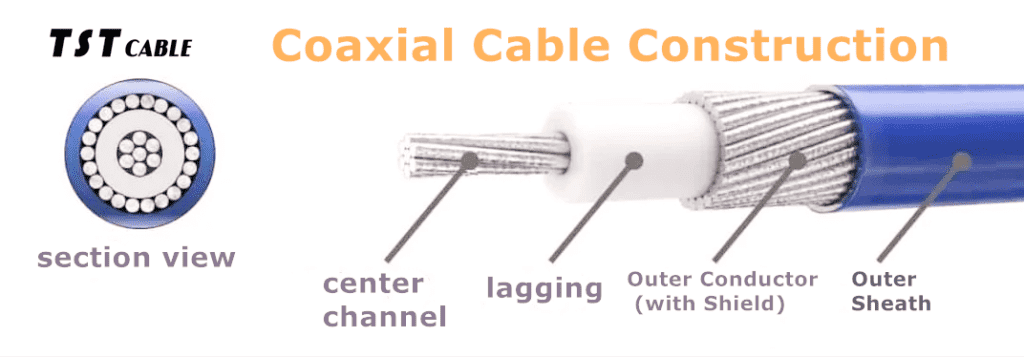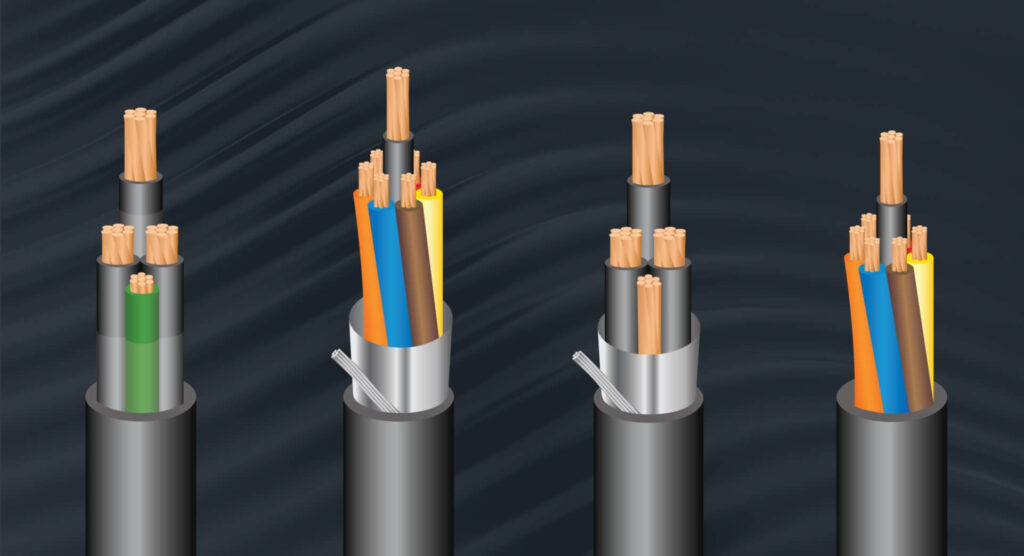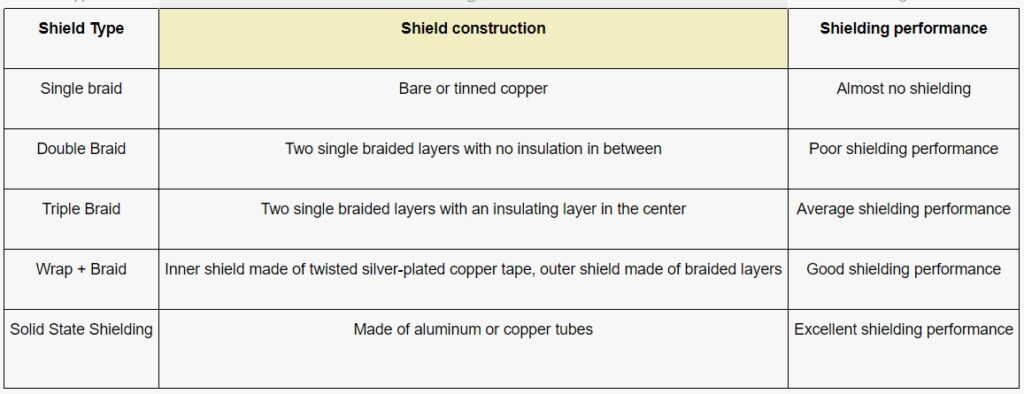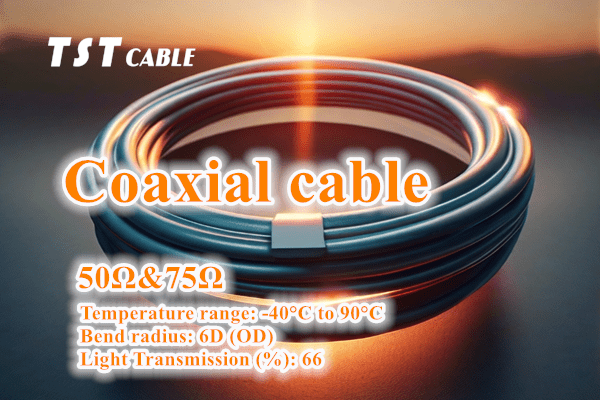What is coaxial cable?

Coaxial cable (Coaxial Cable) refers to two concentric conductors, and the conductor and shielding layer and share the same axis of the cable.
The most common coaxial cable consists of a center conductor, a layer of insulating material, a shield made of mesh fabric, and an external layer of isolation material, the structure of which is shown in the figure above.
Application of coaxial cable
Coaxial cable has a wide range of applications, coaxial cable can transmit analog and digital signals in a low-loss manner, suitable for a variety of applications, including common television broadcasting systems, long-distance telephone transmission systems, short-distance patch cords between computer systems, and local area network interconnections.
Classification of coaxial cable
Coaxial cable can be divided into baseband coaxial cable and broadband coaxial cable (i.e., network coaxial cable and video coaxial cable) from the use of points. Coaxial cable according to different impedance values are divided into two categories, 50Ω and 75Ω, of which 50Ω models for digital signal transmission, 75Ω signal for video signal transmission.
Baseband cables are further divided into fine coaxial cables and coarse coaxial cables. Baseband cables are used only for digital transmission, with data rates up to 10 Mbps. coaxial cables (Coaxial) are cables that have two concentric conductors, with the conductors and layers sharing the same axis. The most common type of coaxial cable consists of copper wire conductors isolated by insulation.
Coaxial cables are growing rapidly as a means of distributing television signals to thousands of homes, which are cable television networks. A cable TV system can carry dozens or even hundreds of TV channels, and its transmission range can reach tens of kilometers.
Coaxial cable related terms
Attenuation (insertion loss): Attenuation is the part of energy lost in the transmission process, usually use “dB/length” as the unit of calculation, for example: 31.0dB/100inch. attenuation will increase with the increase in frequency;
Bend radius: the smallest radius that a cable can be bent without affecting any performance;
Center Conductor: The wire at the center of the coaxial cable, either single or multi-stranded. Conductor diameter is measured using “AWG (American Wire Gauge)”;
Coaxial Adapter: A device used to convert different types of connectors or to convert male and female connectors (e.g., BNC to SMA adapter);
Coaxial connector: a connecting device located at both ends of a coaxial cable assembly. Commonly used coaxial connector models are diverse, such as: BNC, SMA, SMB, F-type;
Insulation: insulating material that separates the center conductor from the shield;
Electromagnetic interference: electrical or electromagnetic energy that can cause damage to electronic signals;
Impedance: the obstruction to current in an AC or variable-current circuit, measured in ohms (Ohms). Two common impedance values in coaxial cables are 50 Ohms and 75 Ohms, used for data and video signal transmission, respectively;
Insertion Loss: The attenuation value measured before and after accessing the output of the system when connected to cables and equipment;
RF: frequency range of 3MHz to 300GHz called “RF”, mainly used for wireless and TV signal transmission;
Shield: a conductive wrapping layer, made of wire preparation layer or metal foil, wrapped around the insulation layer and the center conductor, common types of shielding layer and shielding effectiveness: 1. single-layer preparation layer shielding (95% coverage) 2. single-layer preparation layer shielding (60%) + aluminum foil winding (100%);
Propagation speed: usually expressed as a percentage, refers to the ratio of the speed of electrical energy propagation to the speed of light in a certain length of cable;
Voltage Standing Wave Ratio (VSWR): the ratio between the maximum and minimum values of the effective voltage measured in an RF transmission line. The ratio usually increases with increasing frequency, and the larger the ratio, the greater the capacity loss and the lower the efficiency.

Coaxial cable performance
Performance of coaxial cable
1. Shielding characteristics
Shielding characteristics is an important parameter to measure the anti-interference ability of coaxial cable, and also an important parameter to measure the anti-leakage ability of coaxial cable. Poor shielding will affect the signal quality. Shielding properties are mainly determined by the structure of the outer conductor of the cable, as can be seen from this comparison table below, solid-state shielding is the best, which is common in rigid or semi-rigid coaxial cables.

2. Characteristic impedance



Where: R for the unit length of the resistance; L for the unit length of the inductance; G for the unit length of the conductance; j is the imaginary part of the complex; C for the unit length of the capacitance. As can be seen from the above formula, the characteristic impedance changes with the frequency f, assuming that the internal and external conductors are ideal conductors, then R and G is negligible, so: that is, the characteristic impedance has nothing to do with the frequency, depends entirely on the inductance and capacitance of the cable. The inductance and capacitance is related to the conductor material, the medium between the inner and outer conductor and the inner and outer conductor diameter, expressed by the formula: where ε is the relative permittivity of the insulator, which varies with the density of the material type, D is the inner diameter of the outer conductor, d is the outer diameter of the outer conductor.
In order to ensure optimal transmission, the terminal load impedance should be equal to the characteristic impedance of the cable as far as possible.
3. Attenuation characteristics

Coaxial cable attenuation characteristics are usually expressed in terms of attenuation constant, that is, the unit length (eg, 100m) of the cable on the signal attenuation of the number of decibels. Signal transmission in the coaxial cable when the attenuation and coaxial cable size, dielectric constant, operating frequency.
Where: f is the frequency of the transmitted signal; Z is the characteristic impedance; K is the diameter of the inner and outer conductor, conductivity and shape of the constant; C is small, can be ignored. That is, the attenuation constant is proportional to the square root of the signal frequency, the higher the frequency, the greater the attenuation constant, the lower the frequency, the smaller the attenuation constant.
4. Temperature coefficient
temperature coefficient indicates the degree of influence of temperature change on the characteristics of the cable. Temperature increases, the loss of the cable increases, the temperature decreases, the loss of the cable decreases.
twisted-pair cable and coaxial cable difference
Twisted-pair cable is made of two mutually insulated wires in accordance with certain specifications of mutual winding (generally clockwise winding) together and made of a general-purpose wiring, belonging to the information and communication network transmission medium, which can reduce the degree of signal interference, a wire in the transmission process of the radiation of the waves will be another line of the waves issued by the phase offset. Twisted-pair wires were mainly used to transmit analog signals in the past, but are now equally suitable for the transmission of digital signals.
Also available in:
English




